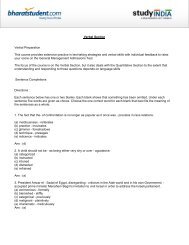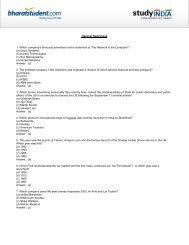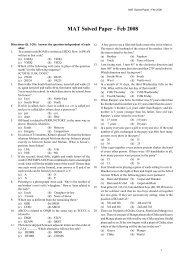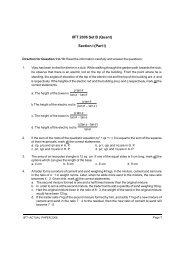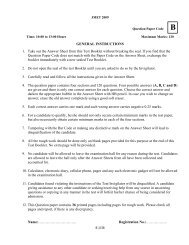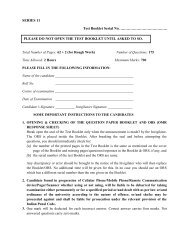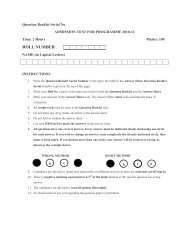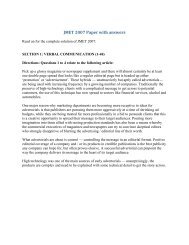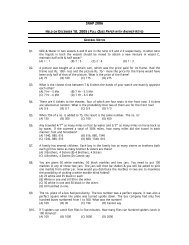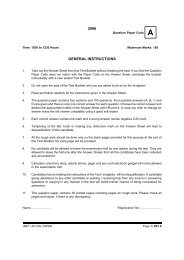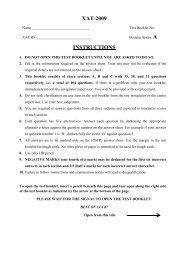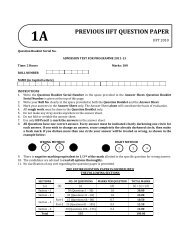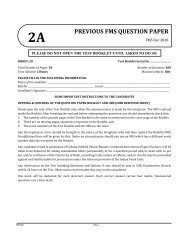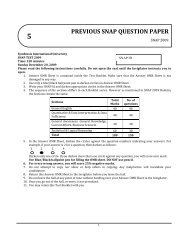ADMISSION TEST FOR PROGRAMME 2008-10
ADMISSION TEST FOR PROGRAMME 2008-10
ADMISSION TEST FOR PROGRAMME 2008-10
You also want an ePaper? Increase the reach of your titles
YUMPU automatically turns print PDFs into web optimized ePapers that Google loves.
Passage 3<br />
In the early 1950s, a plague clouded the American landscape. A mysterious virus<br />
stalked the nation's youth like a silent, invisible killer. For generations, it had been<br />
devouring young lives. But in the previous three decades the number of its victims had<br />
increased dramatically. Those it did not kill, it left hopelessly paralyzed and deformed.<br />
Newspaper artists sometimes depicted the disease as a dragon. Its common name was<br />
infantile paralysis, or poliomyelitis, or simply polio.<br />
Polio struck every summer, turning strong bodies into crumpled ones, leaving in<br />
its wake withered limbs in steel braces and straps. It was simply expected when the<br />
children returned to school each fall that a friend or classmate would have been lost to<br />
polio over the summer. Everyone knew a victim - if not in their own family, it was the<br />
boy down the street or one on the next street. By the early 1950s, some 50,000 cases per<br />
year were being reported, and 1952 alone saw 59,000 new cases.<br />
But in April of 1955 a miracle occurred. It came in the form of an announcement<br />
that a vaccine had been discovered that could actually prevent polio. With completion of<br />
a series of research field tests, the news media hailed it as the most dramatic<br />
breakthrough in the history of medical research.<br />
The hero of the day; the man who slew the polio dragon, was a shy young doctor<br />
named Jonas Salk. Stories of his heroic effort to perfect his vaccine filled the newspapers.<br />
In the months prior to final development of the vaccine, Salk had pushed himself to the<br />
limits of human endurance. Realizing he was close to a breakthrough, he worked seven<br />
days a week, often up to 20 or 30 hours at a time without sleep. He often skipped meals.<br />
The public lionized him for his efforts. But that was not the case among those in the<br />
scientific community. Behind the scenes, unknown to the public, Salk was being vilified<br />
by his peers. At one point some leading scientists even tried to stop distribution of his<br />
life-saving vaccine.<br />
Salk's fellow scientists in biological research considered him an outsider,<br />
intruding into their domain. In fact, in order to acquire funds for his research, Salk had to<br />
go outside normal channels. When he did so, scientists accused him of being a publicity<br />
hound. The research establishment was especially jealous of Salk's relationship with<br />
Basil O'Connor, the man who supplied much of his funding. As president of the National<br />
Foundation for Infantile Paralysis, O'Connor held the purse strings to millions in research<br />
dollars. And he believed in Salk.<br />
Basil O'Connor knew firsthand the devastating effects of the disease. His daughter<br />
had been stricken with polio. And when O'Connor was a young man, Franklin Roosevelt<br />
had been his best friend and law partner, long before becoming president of the United<br />
States. O'Connor had seen polio turn an athletic young Roosevelt into a man unable to<br />
stand without leg braces and walking sticks. In Jonas Salk, O'Connor found someone who<br />
shared his outright hatred for the disease.<br />
37



